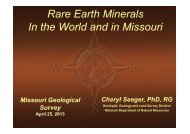Create successful ePaper yourself
Turn your PDF publications into a flip-book with our unique Google optimized e-Paper software.
downstream from older REE m<strong>in</strong>eral concentrations.<br />
flathead sandstone Paleoplacers<br />
The Middle Cambrian Flathead Sandstone, referred<br />
to by some early workers as the Deadwood<br />
Conglomerate, is the oldest sedimentary formation<br />
above the Precambrian <strong>in</strong> Wyom<strong>in</strong>g and has<br />
a maximum thickness of about 170 m (560 ft)<br />
(Kanizay, 1978). Figure 13 shows the locations<br />
of WSGS samples collected from the Flathead<br />
Sandstone. The Flathead is dom<strong>in</strong>antly quartz-rich,<br />
subangular, medium- to coarse-gra<strong>in</strong>ed sandstone<br />
with large-scale cross-bedd<strong>in</strong>g. Non-quartz gra<strong>in</strong>s<br />
<strong>in</strong>clude abundant feldspar and crystall<strong>in</strong>e lithic<br />
fragments typical of the underly<strong>in</strong>g granite. Most<br />
of the formation is th<strong>in</strong>- to thick-bedded and wellcemented<br />
with a predom<strong>in</strong>ant reddishbrown<br />
color that grades to purple, rustyorange,<br />
yellow, or gray. The sandstone is<br />
<strong>in</strong>terrupted by th<strong>in</strong> layers of greenishgray<br />
siltstone and shale, particularly <strong>in</strong><br />
the upper part of the formation. The<br />
Flathead represents a fluvial-mar<strong>in</strong>e<br />
transition zone along a north-south<br />
oriented shorel<strong>in</strong>e with braided stream<br />
deposits <strong>in</strong> the conglomeratic base of the<br />
formation (Middleton, 1980).<br />
The basal conglomerate (fig. 14) varies<br />
from 6 to 15 m (20 to 50 ft) <strong>in</strong> thickness<br />
(McK<strong>in</strong>ney and Horst, 1953).<br />
These braided stream deposits are<br />
quartz-rich, arkosic conglomerates with<br />
subangular to rounded clasts <strong>in</strong>dicative<br />
of both a nearby source and a lack of rework<strong>in</strong>g<br />
(Middleton, 1980). Clast sizes<br />
are up to 5 cm (2 <strong>in</strong>) <strong>in</strong> diameter with<br />
cementation vary<strong>in</strong>g from moderately<br />
silicic or limonitic to localized areas of<br />
quartzite.<br />
bald Mounta<strong>in</strong> Paleoplacers, big<br />
Horn and sheridan counties<br />
The Bald Mounta<strong>in</strong> area sits along<br />
the upper part of the west flank of the<br />
41<br />
northwest-trend<strong>in</strong>g, northern Bighorn Mounta<strong>in</strong>s<br />
at elevations between 2,600 and 2,900 m (8,600 to<br />
9,400 ft). This part of the Bighorn Mounta<strong>in</strong>s is an<br />
asymmetric, Laramide anticl<strong>in</strong>al uplift characterized<br />
by west-dipp<strong>in</strong>g monocl<strong>in</strong>es. Near-horizontal<br />
to east-dipp<strong>in</strong>g exposures of Lower Paleozoic<br />
formations unconformably overlie medium- to<br />
coarse-gra<strong>in</strong>ed, p<strong>in</strong>k to gray, Archean plutonic<br />
rocks that generally vary from granitic to quartz<br />
dioritic <strong>in</strong> composition. The granitic rocks locally<br />
conta<strong>in</strong> m<strong>in</strong>or pegmatites and are cut by more than<br />
one generation of mafic dikes (Osterwald, 1959;<br />
Hausel, 1989). Mafic dikes <strong>in</strong> the Bald Mounta<strong>in</strong><br />
area were mapped as hornblende-diorite by Card<strong>in</strong>al<br />
(1958).<br />
figure 14. Conglomerate of the lower Flathead Sandstone. A, outcrop<br />
of the basal conglomerate from which sample 20130824WS-D was<br />
collected. B, close-up of sample 20110824WS-D, conglomerate<br />
from the lower Flathead Sandstone.



